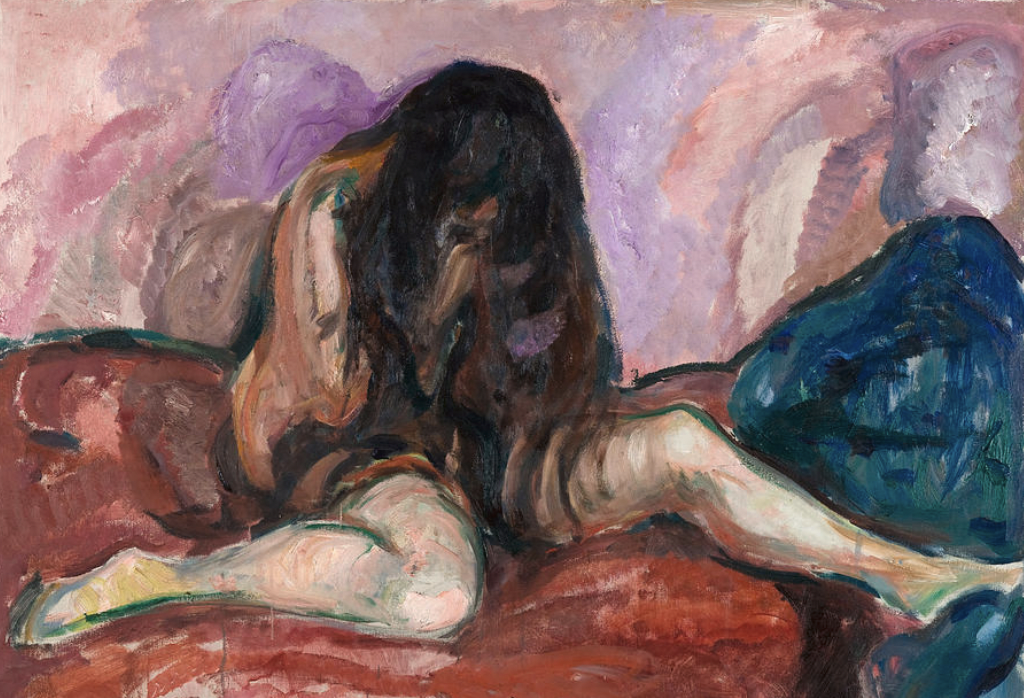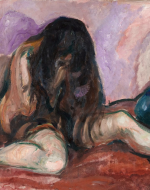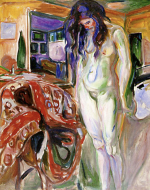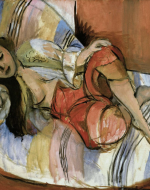Created by hannah mclaughlin on Fri, 02/16/2024 - 16:42
Description:
Display Explanation:
In placing my installation in a museum, I have put a lot of thought into how the coloring and positions of the women's bodies would compliment each other when presented in a room. As well as placed in a purposeful way that they could be viewed as belonging together meaning that all three pieces share the same philosophy or so that viewers could see a theme across the installation. To have the colors really pop and to focus on the paintings themselves, I would place them on a blank white wall in simple gold frames with a spotlight placed on each painting while the rest of the room is dim-light or basically dark so the focus is entirely on the paintings themselves. When looking at all three pieces on the wall I think it would look best to place them in a triangle or pyramid formation so they can all be viewed individually but it will also be easy to see them as a whole without just placing them in a straight line. This way people can focus on one piece at a time at first glance. First, I would place one of the Edvard Munch paintings, ‘The Model by The Wicker Chair’ higher up on the wall at the top of the pyramid. Because of the positioning of the woman’s head it is as if she is looking down at the other two women when being placed higher up. The coloring of this piece is also much more vibrant than the other two so having it not placed directly next to another piece makes it easier to focus on just that one piece rather than eyes bouncing between the three pieces. Placed underneath on the left side would be ‘Weeping Nude’ the other Munch painting. Since the woman’s body is positioned facing to the right, it would look as if she was positioning herself towards the other women to make them appear as a group. The coloring of this piece is slightly dimmer as well as more realistic looking so it will contrast in comparison to ‘Model by The Wicker Chair’ placed above it. Lastly, to the bottom right of the pyramid, I would place the final piece which is the Henri Matisse piece called Odalisque’. This woman's body is leaning to the left as if she is leaning towards the other two women. Once again, the color palette of this painting is not as vibrant as the top painting but has a similar palette in comparison to ‘Weeping Nude’. Having these three pieces placed in the pyramid type formation, gives them an opportunity to be interpreted all together as well as individually. Having them placed about a foot or two apart on the wall will be able to give viewers enough space to be able to focus on each individual piece when standing up close. As they back away from the group of paintings viewers will be able to take away the same theme of sadness and comfortability in their nude bodies and/ or sexuality across all three pieces of artwork.
Installation Note:
Across all three pieces of artwork, the same philosophy or theme involving sexuality can be taken away from viewing the installation I have put together. This being the idea that all three of these images offer visions of women confident enough in their bodies to simultaneously expose their bodies and their painful emotions. In all three of the paintings, it is obvious they are all upset for whatever the reason may be. All three of the women are also displaying that emotion in different ways. In ‘Weeping Nude’ it states it clearly in the title, she is crying and appears to be very distraught. Even without knowing the title of the piece, it is quite obvious she is sobbing. When looking closely at the positioning of her legs, it is clear she isn’t focused on how she looks at that moment; it’s almost as if she is sprawled out or threw herself to the ground. Because of this position she is in, it is easy to infer the portrait wasn’t posed. She is so deep in her emotions to care about covering up her nude, exposed body. Consistent with the sense of sadness, in ‘Model by The Wicker Chair, we cannot say with a hundred percent certainty whether or not the woman is crying but the positioning of her head looking down insinuates she is upset or maybe disappointed. Once again, the woman pictured does not appear to be posed in any way, another relaxed, natural position. She isn’t purposely trying to cover any parts of her body up, she is entirely exposed. In keeping with the other two, with the Matisse painting the viewer can also see she is feeling some feeling of sadness or distress. Viewers can also see that she, too, is sitting in a very natural position with her leg propped up and her body slouching over. While there is a blanket draped over her legs covering some of her body, she doesnt appear to be purposely trying to hide the exposed portions. All three of these women are not hiding their emotions or covering up their bodies which makes them all seem very authentic. This stance across all three paintings in the installation is particularly unique because so often we think of nude bodies as for displays that could bring happiness, excitement, inspiration. Which is obviously the complete opposite of what I chose to represent in my installation because I found it so interesting to see. Rather than having these women pose in a way that is very staged and inauthentic, these pieces portray raw, natural emotion. Simultaneously representing vulnerability. The women are not covering up or hiding their bodies because they are so deep in emotion and their thoughts. Because of this authenticity, I felt these pieces could possibly make viewers feel more emotions. Whether that may be emotions they could be feeling towards the women in the paintings; meaning feeling empathy or sorrow for them. Or just feelings internally that they may take away from viewing the collection in general.
MLA
Munch, Edvard, Model By The Wicker Chair, 1921,
Edvard Munch, ‘Weeping Nude’, 1913-14,
Matisse, Henri. Odalisque. 1920.
Copyright:
Associated Place(s)
Featured in Exhibit:
Artist:
- Multiple Artists




